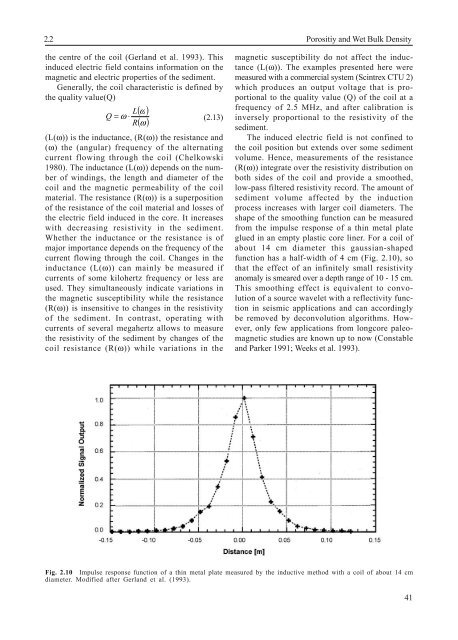2 Physical Properties of Marine Sediments - Blogs Unpad
2 Physical Properties of Marine Sediments - Blogs Unpad
2 Physical Properties of Marine Sediments - Blogs Unpad
You also want an ePaper? Increase the reach of your titles
YUMPU automatically turns print PDFs into web optimized ePapers that Google loves.
2.2 Porositiy and Wet Bulk Densitythe centre <strong>of</strong> the coil (Gerland et al. 1993). Thisinduced electric field contains information on themagnetic and electric properties <strong>of</strong> the sediment.Generally, the coil characteristic is defined bythe quality value(Q)L( ω)Q = ω ⋅(2.13)R ( ω)(L(ω)) is the inductance, (R(ω)) the resistance and(ω) the (angular) frequency <strong>of</strong> the alternatingcurrent flowing through the coil (Chelkowski1980). The inductance (L(ω)) depends on the number<strong>of</strong> windings, the length and diameter <strong>of</strong> thecoil and the magnetic permeability <strong>of</strong> the coilmaterial. The resistance (R(ω)) is a superposition<strong>of</strong> the resistance <strong>of</strong> the coil material and losses <strong>of</strong>the electric field induced in the core. It increaseswith decreasing resistivity in the sediment.Whether the inductance or the resistance is <strong>of</strong>major importance depends on the frequency <strong>of</strong> thecurrent flowing through the coil. Changes in theinductance (L(ω)) can mainly be measured ifcurrents <strong>of</strong> some kilohertz frequency or less areused. They simultaneously indicate variations inthe magnetic susceptibility while the resistance(R(ω)) is insensitive to changes in the resistivity<strong>of</strong> the sediment. In contrast, operating withcurrents <strong>of</strong> several megahertz allows to measurethe resistivity <strong>of</strong> the sediment by changes <strong>of</strong> thecoil resistance (R(ω)) while variations in themagnetic susceptibility do not affect the inductance(L(ω)). The examples presented here weremeasured with a commercial system (Scintrex CTU 2)which produces an output voltage that is proportionalto the quality value (Q) <strong>of</strong> the coil at afrequency <strong>of</strong> 2.5 MHz, and after calibration isinversely proportional to the resistivity <strong>of</strong> thesediment.The induced electric field is not confined tothe coil position but extends over some sedimentvolume. Hence, measurements <strong>of</strong> the resistance(R(ω)) integrate over the resistivity distribution onboth sides <strong>of</strong> the coil and provide a smoothed,low-pass filtered resistivity record. The amount <strong>of</strong>sediment volume affected by the inductionprocess increases with larger coil diameters. Theshape <strong>of</strong> the smoothing function can be measuredfrom the impulse response <strong>of</strong> a thin metal plateglued in an empty plastic core liner. For a coil <strong>of</strong>about 14 cm diameter this gaussian-shapedfunction has a half-width <strong>of</strong> 4 cm (Fig. 2.10), sothat the effect <strong>of</strong> an infinitely small resistivityanomaly is smeared over a depth range <strong>of</strong> 10 - 15 cm.This smoothing effect is equivalent to convolution<strong>of</strong> a source wavelet with a reflectivity functionin seismic applications and can accordinglybe removed by deconvolution algorithms. However,only few applications from longcore paleomagneticstudies are known up to now (Constableand Parker 1991; Weeks et al. 1993).Fig. 2.10 Impulse response function <strong>of</strong> a thin metal plate measured by the inductive method with a coil <strong>of</strong> about 14 cmdiameter. Modified after Gerland et al. (1993).41
















